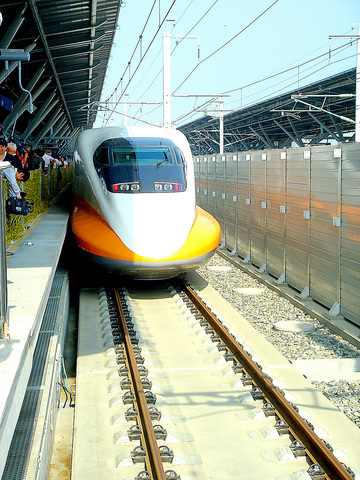After four months of delays, the Taiwan High Speed Rail Corp (THSRC) began its first test run of Taiwan's bullet train yesterday, hoping to begin regular service by the end of October, as orginally scheduled.
"Only months from now, people in Taiwan will see the trains flying along the west coast of Taiwan," said THRSC chairwoman Nita Ing (

PHOTO: JESSIE HO, TAIPEI TIMES
Over the next four to six weeks, THSRC will test the train on a 60km-track between Kaohsiung and Tainan, starting at the speed of 30kph, and then gradually gearing up to 120kph.
Kazuo Sato, chairman of the Taiwan Shinkansen Corp, who also attended the inauguration, said the train has passed tests running at 300kph in Japan, and that the company will help THSRC to resolve technical problems, allowing the train to roar along at the same speed on Taiwan's tracks.
The 700T train, based on the Japanese Shinkansen 700 Series, has been modified to accommodate Taiwan's environment, and has 12 carriages, including nine motor cars and three trailer cars that can carry a total of 989 passengers. THSRC has ordered 30 complete train sets, which will be delivered to Taiwan by the end of September.
THSRC has completed 78 percent of the 345km project, which connects the northern and southern parts of the country, but the progress seems to be slow, given the Oct. 31 deadline for completion that the company has set.
Ing was noncommittal as to whether the company can meet the deadline, saying: "As the leader of this project, I have to have confidence that it will be completed on time ... We can't predict the future, but we will try our best."
Formosa Plastics Group chairman Wang Yung-ching (
THSRC failed to meet its target of NT$7.5 billion (US$236.6 million) in investment by the end of last year, and is keen to find potential investors to resolve its burgeoning financial crisis.
According to Arthur Chiang (
Ing dismissed media reports that the Taiwan high-speed railway is a hybrid mix of Japanese and European systems with many safety concerns. Chiang explained that THSRC only uses larger turnouts -- a type of track structure necessary for switching to parallel rails -- made in Germany on four steep slopes, as required by the Taiwan High Speed Rail Bureau, while the rest of the parts and components are from the Japanese Shinkansen system.
The turnouts have passed tests in Germany, and thus pose no threat to passenger safety, Chiang said.

Auckland rang in 2026 with a downtown fireworks display launched from New Zealand’s tallest structure, Sky Tower, making it the first major city to greet the new year at a celebration dampened by rain, while crowds in Taipei braved the elements to watch Taipei 101’s display. South Pacific countries are the first to bid farewell to 2025. Clocks struck midnight in Auckland, with a population of 1.7 million, 18 hours before the famous ball was to drop in New York’s Times Square. The five-minute display involved 3,500 fireworks launched from the 240m Sky Tower. Smaller community events were canceled across New Zealand’s

The Ministry of Foreign Affairs (MOFA) yesterday said it is closely monitoring developments in Venezuela, and would continue to cooperate with democratic allies and work together for regional and global security, stability, and prosperity. The remarks came after the US on Saturday launched a series of airstrikes in Venezuela and kidnapped Venezuelan President Nicolas Maduro, who was later flown to New York along with his wife. The pair face US charges related to drug trafficking and alleged cooperation with gangs designated as terrorist organizations. Maduro has denied the allegations. The ministry said that it is closely monitoring the political and economic situation

‘SLICING METHOD’: In the event of a blockade, the China Coast Guard would intercept Taiwanese ships while its navy would seek to deter foreign intervention China’s military drills around Taiwan this week signaled potential strategies to cut the nation off from energy supplies and foreign military assistance, a US think tank report said. The Chinese People’s Liberation Army (PLA) conducted what it called “Justice Mission 2025” exercises from Monday to Tuesday in five maritime zones and airspace around Taiwan, calling them a warning to “Taiwanese independence” forces. In a report released on Wednesday, the Institute for the Study of War said the exercises effectively simulated blocking shipping routes to major port cities, including Kaohsiung, Keelung and Hualien. Taiwan would be highly vulnerable under such a blockade, because it

UNRELENTING: China attempted cyberattacks on Taiwan’s critical infrastructure 2.63 million times per day last year, up from 1.23 million in 2023, the NSB said China’s cyberarmy has long engaged in cyberattacks against Taiwan’s critical infrastructure, employing diverse and evolving tactics, the National Security Bureau (NSB) said yesterday, adding that cyberattacks on critical energy infrastructure last year increased 10-fold compared with the previous year. The NSB yesterday released a report titled Analysis on China’s Cyber Threats to Taiwan’s Critical Infrastructure in 2025, outlining the number of cyberattacks, major tactics and hacker groups. Taiwan’s national intelligence community identified a large number of cybersecurity incidents last year, the bureau said in a statement. China’s cyberarmy last year launched an average of 2.63 million intrusion attempts per day targeting Taiwan’s critical